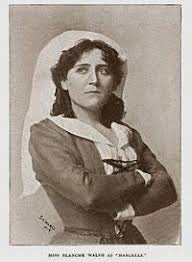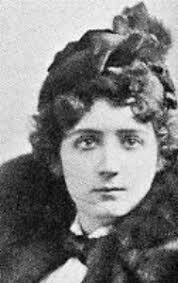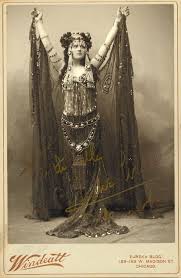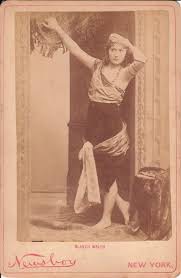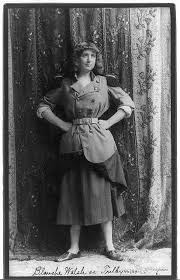“Can we imagine a Hollywood for the greater good?”- John Bredin
John Bredin is a writer, educator, visionary thinker, activist, TV show host, filmmaker, actor, and businessman. His prevailing project honors his ancestral connection to one of America’s first movie stars, Blanche Walsh, who was excluded from the history of times past due to the unaccounted whereabouts of the only film she starred in, Resurrection (1912). Martin Scorsese, the filmmaker who doubles as a film historian, has noted the weight of lost films in present-day society: “With every foot of film that is lost, we lose a link to our culture, to the world around us, to each other, and to ourselves” (Ochoa). Although Walsh’s film remains missing, John Bredin articulates the unrecorded life of Blanche Walsh for our culture, the world around us, each other, and ourselves in hopes of earning, in Walsh’s remembrance, an honorary Oscar and a star on the Hollywood Walk of Fame. Ultimately, Bredin is devising a pathway, in film scholarship, with sufficient room to grow, for an Old Hollywood star, Blanche Walsh, with cultural, traditional, and historical remediation as the pathway’s destination. By rewriting the birth of cinema and preserving the power of love and social justice, upon which its foundations were assembled, he aspires to impart a Hollywood that serves the greater good. John Bredin participated in this interview with Film Matters via email in summer 2018.
Lily Frame: Elaborate on your previous career paths as a writer, educator, visionary thinker, activist, TV show host, filmmaker, actor, and businessman.
John Bredin: I wrote a story at the age of eight titled “The Horse Player.” It was a satire on my uncle Ally, a real-life Damon Runyon character who lived in New York City and was the black sheep of our family. He loved to play the horses, palled around with a famous gangster, and came out with funny sayings like “No munya, no funya” and “Romance without finance is a nuisance.” I found him colorful and fascinating enough to want to write about.
Growing up, I was a shy, bookish kid, attracted to literature and writing but never one of the “cool” ones. I would’ve been a nerd in Happy Days, one of my favorite TV shows in the seventies—never the Fonze! In some way, my entire life project has been a struggle to find my voice, in the community and in the world. To learn how to tell my stories with confidence; and maybe even panache. A project that grew more focused when I became an English professor (helping others to find their voices) and, now, as I call myself: a teacher with a talk show. As my political consciousness grew, I also discovered the link between language and power in society; which added a democratic, liberating aspect to my vocation.
In my brushes with the business world, I found myself too humanistically oriented, not cutthroat enough to fit in. Like when I got fired from my job as a bank teller for talking too much to the customers! It makes me laugh now when I realize I was “in rehearsal” for my future career as a talk show host. In my brief foray into real estate, reacting to the selfishness and emptiness I sensed, I created a think tank called the Ethical Business Society, along with a radio show, New Bottom Line, to nurture a more humane corporate culture which puts the needs of people and the planet over profits. And I wrote a series of books on ethical business with titles like Money for Justice and Spy in the House of Capitalism.
In 2010, I found my true calling when my wife Claudia said “yes” to my dream of creating a TV show. Together we launched the nonprofit talk show Public Voice Salon, an open dialogue on education, the arts, and social change. Dedicated to keeping alive the humanities in an increasingly technocratic society, we believe in the importance of community, imagination, stories, and the art of human dialogue: subjects rarely discussed on mainstream media. We’ve featured some of the world’s leading intellectuals and cultural luminaries as our guests. Not to hawk products, but to discuss ideas. Recently, we visited with towering literary critic Harold Bloom at his home in New Haven, Connecticut. Harold issued a dire warning about the growing neglect of literature in the academy; a warning we take seriously.
LF: Tell me about your latest project “Imagine a Hollywood for the Greater Good.”
JB: I’m on a mission to rewrite Hollywood’s birth narrative to highlight its unknown ethical origin. Let me explain. Contrary to popular opinion, Birth of a Nation (1915) was not the first American feature film. Given that film’s nefarious racist elements, this amazing discovery is cause for “dancing in the streets”-level celebration. But the story gets even better.
The real first American feature movie, Resurrection (1912), was a tribute to the power of love and social justice. It was as morally and spiritually enriching as Birth of a Nation is vile and repugnant. The reason we don’t know about it is because the film itself was lost and, over the years, memory of it has faded into obscurity. It was based on Tolstoy’s most provocative, political, and bestselling book—a book he wrote to raise money for a pacifist religious group who were being persecuted by the Czar and needed to emigrate to Canada. They came to Tolstoy for money because he was a noted pacifist; having influenced Gandhi, who, in turn, influenced MLK. Even the backstory behind Resurrection reads like a novel!
The movie starred Blanche Walsh, a great forgotten actress who was also my grandmother’s dear second mother.
The plot of the film involves a wealthy aristocrat, Neklyudov—with left-leaning sympathies—who falls in love with the peasant Maslova and, as the story unfolds, becomes more and more compassionate toward the poor: to the point where he starts giving his property away. That’s my kind of one-percenter! It turns out, however, that he had an affair with Maslova years before, got her pregnant, then abandoned her. Serving on a jury trial, he’s shocked to discover “the one he left behind” as a prostitute accused of a crime she didn’t commit. Wracked by guilt, Neklyudov vows to rescue her. It was in this novel that Tolstoy declared, “Love is the fundamental law of human life.”
Once we reacquaint Americans with this, the REAL first American feature movie (not the racist Birth of a Nation), we magically have a completely different birth story for Hollywood. It could be as paradigm changing for Hollywood as Copernicus’s discovery that the sun was the real center of the solar system. Imagine, a movie about love and social justice was the first real “big one” of Hollywood, not a work of hateful propaganda. After we “ethically reboot” Hollywood’s birth tale, the next step is to envisage a though-line of what I call “Hollywood for the greater good”: an archipelago of morally substantive films like Modern Times [1936], Mr. Smith Goes to Washington [1939], Do the Right Thing [1989], Bulworth [1998], and Selma [2014]. This will help us in our future quest (starting now) to imagine an even greater role for a world-saving, justice-loving cinema.
LF: How do you plan to utilize your career facets within your project?
JB: Great question. As host of an educational talk show, it allows me to disseminate lost cultural knowledge to a broader audience. When our guests are from the world of theater and cinema, I find they’re especially fascinated to learn about Blanche Walsh and Resurrection. It lends itself naturally to a topic of conversation. Since our TV show has an intellectual and humanistic aspect, and the Blanche Walsh story is itself a convergence of literature, theater, cinema, and personal story, they go together nicely.
Show business is also a common factor. One of our former guests, Joe Franklin—the man who invented the talk show in 1950—was excited to learn about the Blanche Walsh story. In my “Imagine a Hollywood for the Greater Good” lecture tour, I like to mention our TV show as an example of how the media can be a site of humanistic growth, community building, intellectual ideas, and civic education: goals Hollywood can address too if it likes. I also draw psychological strength from my ancestral connection to Blanche Walsh. Being part of this unique cultural lineage keeps me strong and focused. It even gives me a feeling of destiny—a magic connection to Hollywood and Broadway at their best!—in my work as host of Public Voice Salon. Knowledge of my ancestry endows me with a deeper sense of purpose and meaning in our quest to bring a humane transformation to media.
LF: Who was Blanche Walsh?
JB: Blanche Walsh was one of the greatest stars of the American stage during the late Belle Époque period: 1890-1915. She was America’s version of Sarah Bernhardt and Eleanora Duse. Victorien Sardou, creator of the “well-made play,” wrote plays specifically for Sarah Bernhardt. When they were performed in New York, Blanche Walsh played the roles. She starred in Trilby, a Belle Époque sensation that helped inspire Phantom of the Opera; La Tosca (before it was an opera by Puccini); and the first stage adaptation of Tolstoy’s Resurrection. Born on Mott Street in Manhattan’s immigrant-teeming Lower East Side, her father was Tammany Hall big shot, Fatty P. Walsh.
Walsh was also the original advocate of an American national theater. Long dreamed about but never achieved, Walsh got the idea from her friend Mark Twain: but took the ball and ran with it. She felt we needed a national theater to prevent the lure of fast profits from turning serious theater into commercial fluff; a problem even in the 1890s! In the foyer of her Brooklyn mansion hung a diagram suggesting what she called “The National Liberal Theater of America” would look like. The idea was simple. A chain of theaters nationwide would present serious plays for the general public at a low cost. Once a week was reserved for an intellectual lecture. An international arts magazine, with a focus on theater, would also be attached to the project.
In 1912, when Adolph Zukor was inventing the motion picture industry—along with the notion of a “movie star”—he cast Blanche Walsh in his original production: Resurrection. Her one contribution to cinema turned out to be as epic as it was groundbreaking. In a dramatic story from the stage of her real life, she also rescued my paternal grandmother Doris from an orphanage in London and brought her safely to NYC—where she looked after her like a second mother. I call this my real-life fairy tale.
LF: What is your relationship to Blanche Walsh?
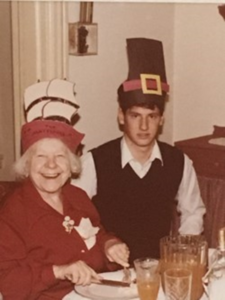
John Bredin and his grandmother, Doris Bredin, during a past Thanksgiving celebration. Courtesy of John Bredin
JB: I learned about Blanche Walsh from my grandmother Doris Bredin, who had a natural theatrical personality. We used to take long walks together, and she loved to regale me with stories from her past—especially over a cup of tea. She never lost that English way: “It’s four o’clock, John, time for tea,” she’d call me from the kitchen. Though she never went into show business herself (her unfulfilled dream was to be a singer), she used to sing to me as a child. I still know all the words to “Baby Face”! At the drop of a hat, she’d break into a song…as if we were living in a musical! She also taught me the fairy tales, including the real-life “Cinderella story” of how a great American actress became her guardian angel.
My grandmother never knew her dad. He took off when she was born. She was being raised by a single mother who worked as a chambermaid in a London hotel. One day, when Blanche Walsh was staying there, she befriended my great-grandmother and gave her a job as her head wardrobe lady in New York. While unpacking the trunk, a photo of a little girl tumbled out. “Who’s that lovely child?” inquired the actress, and my great-grandmother started to cry. “She’s my daughter. I didn’t think I could bring her, so I put her in an orphanage.” The next line spoken in this real-life scene was by Blanche Walsh, who said: “Look at this lovely child. We can’t leave her behind. I’ll send for her right away.”
And so my grandmother sailed first class across the mighty Atlantic on the American Star Liner, the most luxurious cruise ship before the Titanic, past the Stature of Liberty, and was picked up by a chauffeured limo waiting at the Hudson River dock. Then it was on to Blanche Walsh’s Park Avenue duplex. The stuff dreams are made of.
You might call Blanche Walsh my spiritual great-grandmother. She’s an example of what Gloria Steinem means when she talks about “found family,” the crucial role people outside our families—often people in the community, or sometimes even a complete stranger—can play in enriching, or even saving our lives. Though she died at the young age of forty-two (she was overworked and exhausted), I believe that the potential impact of Blanche Walsh on our culture might be yet to come. Which is why it’s so important to get her story out there.
LF: You stated Blanche Walsh became America’s first movie star in its first feature-length film produced by Adolf Zukor known as Resurrection, but within The New York Times archives it was specified “…[i]n 1912 he [Adolph Zukor] made entertainment history when he daringly offered the American public its first feature-length film, Queen Elizabeth (1912).” Can you produce evidence which verifies Resurrection was the earliest American feature-length film, thus yielding Blanche Walsh as the first American movie star?
JB: Before Adolph Zukor, films where mostly ten or twenty minutes long—one or two reels—and lacked a complex storyline. It was the canny Hungarian immigrant Zukor’s idea to make feature-length films (forty minutes or longer), similar in structure to a novel, play, or magazine article. He also created the category of a “movie star,” since banks were more likely to fund his projects if he had a “bankable star.” Zukor’s third innovation was to cast stars of the “legitimate stage” in his films, to lure in the upper classes who originally turned their noses up on the movies; which they deemed an inferior art form for the unwashed masses. In fact, the tagline for Zukor’s first movie company, Famous Players Studio (which later became Paramount)—was “Famous Players in Famous Plays.”
He launched the company with Queen Elizabeth, a filmed play of Sarah Bernhardt made in France. Zukor didn’t make the film. He simply financed it, acquiring the sole distribution rights in the United States. In a bold stroke of genius, he premiered it at the Lyceum Theater on Broadway, thus lending it the imprimatur of theatrical legitimacy. The erudite classes flocked to see it in droves. Suddenly, “the movies” had a stamp of cultural acceptability. The next day, a journalist wrote a review of the film, the first time this ever happened. To his dying day, and he lived to 103, Zukor was so proud to have his movie “written about in the papers”! The writer also used a peculiar word never before applied to a movie. He said it was “starring” Sarah Bernhardt.
His star theory proven, three months later, Zukor released his first original production: Resurrection, starring Blanche Walsh. That’s why I say Blanche Walsh was the first American movie star. To avoid any potential arguments, however, since I realize that Florence Lawrence and Mary Pickford were also being promoted in a starlike fashion around that time, I say Blanche Walsh was “one of the first American movie stars.” But she’s certainly the one who’s been forgotten.
LF: Adolf Zukor’s Resurrection is classified as a lost film, but it is most significantly regarded as the only American feature-length film Blanche Walsh starred in. With the substantial loss of her vehicle to stardom, how have you accomplished the exploration into Walsh’s filmic presence?
JB: I recently discovered that the New York Public Library for the Performing Arts, located at Lincoln Center, has artifacts on Blanche Walsh in Resurrection. I’m also reaching out to places like Film Forum, Anthology Film Archives, the Film Study Center at MoMA, and the American Film Institute. And I have plans to contact the Library of Congress and the organization created by Martin Scorsese, The Film Foundation. Let me also use the “stage” of this interview to call on a worldwide search for the lost classic Resurrection, the first American feature film. Who knows, it might be in somebody’s attic somewhere. Every once in a while a print of an old lost film will suddenly, and mysteriously, resurface; sometimes from faraway places in Europe or South America.
LF: What further research challenges have you experienced?
JB: Even the challenges of this project are, for me, like magical opportunities. For example, the fact that the film is lost makes it all the more crucial for me to speak about it in public. By giving the film a voice in the public square, which I do in my lectures (and a one-man show that’s in development), these orations become the space of memory, articulations to ward off the cultural forgetfulness that swallows up so much of our history…in Blanche Walsh’s case, Her-Story…as important knowledge disappears down the rabbit hole of forgetfulness in our fast-paced, breaking news-oriented consumerist society.
In just the past week, I received some unexpected help from the Russian American Cultural Center in New York City. With so much bad news about Russia these days, American cinema’s secret debt to the great Russian novelist Leo Tolstoy might be the best good-news Russia story of the year: without collusion! On June 20, 2018, I’ll give a talk in the Pelham Bay section of the Bronx, home to a sizable Russian community, on Russia’s forgotten role in the birth of Hollywood. Wish me luck!
LF: In my research, I uncovered your project compiles stories and facts in hopes of educating the world about Blanche Walsh. Can you elaborate on this? With partiality at stake, how do you guarantee integrity?
JB: I was born on Lincoln’s birthday, February 12, so I like to take pride in my honesty. That being said, I am more of an untraditional scholar who likes to combine artistry, performance, and storytelling in my work. Not to mention humor…and a little magic at times. It’s how I keep things interesting. It no doubt has roots in my teaching practice, having taught in culturally diverse, inner-city environments like Newark and Harlem, where you need to be creative and think on your feet to hold the students’ attention.
But I would like to encourage actual cultural historians to research not only Blanche Walsh, but also my new, ethical framing of the birth of Hollywood: a kind of real breaking news in cultural history. A big part of my “research” is simply finding spaces to tell the story about Blanche Walsh. After my lectures, we move to an open dialogue with the audience. I invite folks to ponder how to create a “Hollywood for the greater good.” This form of social learning, pioneered by the great psychologist Lev Vygotsky (another Russian!), is also a way to produce new knowledge: dialogically. It relates to what John Dewey, the great American philosopher, had in mind when he spoke of “social intelligence.” It’s also a fun way to build community.
LF: You hope Blanche Walsh is recognized with an honorary Oscar and a star on Hollywood Walk of Fame. How do you plan on achieving these goals?
JB: By getting more publicity and attention for the project. Including coverage by major news outlets. Just now, I was interviewed by Voice of America’s Russian service, since they love that I’m highlighting Russian literature (Tolstoy) and its link to Hollywood’s birth. They have an audience of about a half million. In addition to this interview, there’s a National Woman’s History Museum in formation in the DC area—which is interested in my Blanche Walsh story. Let me also take the time to thank some very special people who encouraged me to take the project this far. These include film historian Foster Hirsch, feminist film critic Molly Haskell, Pulitzer Prize-winning Broadway producer Daryl Roth, Glenda Jackson (a two-time Academy Award winner who just won her first Tony: go Glenda!), and New York Times co-chief theater critic Jesse Green. Along with all my students, who, in their fascination with my Blanche Walsh story, give me faith in its magic ability to touch many more hearts.
LF: Where do you see your project within the next five years?
JB: Allow me to dream big and say I hope to make Blanche Walsh a household name. To do that, I need to develop a Blanche Walsh cottage industry of books, films, and plays about the great forgotten actress. Personally, I’d prefer to play an advisory role, to help shepherd projects into existence; and be available for consulting purposes—since I’m a direct family link; and I may know more about Blanche Walsh (right now) than anyone else in the known galaxy. This spring, I wrote to Glenda Jackson, telling her about Blanche Walsh, and she actually called me at home! Glenda invited me to visit her backstage, after a performance of Three Tall Women—a magical, life-changing experience—and she encouraged me to continue educating the world about Blanche Walsh. Onward and upward! Now I have my marching orders form Glenda Jackson!
Other prominent actresses I’d like to reach out to include: Jane Fonda (who got her start acting in the same New Jersey theater as my dad and Warren Beatty in the 1950s); Meryl Streep, Drew Barrymore (her great-aunt Ethel Barrymore and Blanche Walsh both “came to notice” in the acting company of Charles Frohman); and Frances McDormand, who impressed me with her chutzpah while accepting her Oscar for Three Billboards Outside Ebbing, Missouri.
In addition to works about Blanche Walsh, I can also imagine a twenty-first-century revival of Tolstoy’s Resurrection—a work that touches on themes like wealth inequality and a corrupt prison system: both of which are still major problems today. Let’s give War and Peace and Anna Karenina a break for a while and focus on a work that relates more to today’s society. In fact, did you know that the most notable Native American filmmaker, Edwin Carewe, actually made two versions of Resurrection? The one in 1927 starred Dolores Del Rio, the first Latina superstar, and then in 1931 with Lupe Velez: another famous Latina known as the “Mexican spitfire” and “hot pepper.” In 1934, Sam Goldwyn tried to turn Ukrainian beauty Anna Sten into the next Greta Garbo by casting her in We Live Again—a renamed version of the Resurrection story—also starring Fredric March.
I’d say Resurrection is long overdue to be revisited, both theatrically and cinematically. Not to mention the novel itself, which I nominate for next year’s “Great American Readout.”
My own personal fantasy would be to develop a play (one-man show) about Blanche Walsh that also touches on my work as a teacher. An educational play that combines the literary, filmic, theatrical, and even civic aspects of this story. I say civic because the Tolstoy novel that inspired the movie Resurrection was itself steeped in social justice. Two years ago, when I began experimenting with this play idea, I mounted the first performance of it in a church on Central Park West. In a six-degrees-of-separation moment, I became friendly with an audience member who connected me with Richard Dreyfuss—the actor and civics advocate—whom I began helping in his project to revive the lost art of civics education: both in schools and in the community.
I think it’s an amazing act of synchronicity that, as a direct result of my first one-man show—which, by the way, was titled How to Be an Actor in Your Own Life—I wind up meeting an Academy Award-winning actor! This was also in keeping with a key principle of my teaching philosophy: to live a life that isn’t boring. As long as I keep moving forward with the Blanche Walsh project, I’m confident the universe will continue to meet me halfway.
LF: If you were to meet Blanche Walsh, what would you say?
JB: I would thank her for rescuing my grandmother and becoming her second mother. Then I’d give her a big hug and kiss.
I would ask if she knew about the new experiments in theater that had just begun to percolate in her time; inspired by the Stanislavski method and the Moscow Art Theater. My theory is that, had she been exposed to the more humanistic trends in theater, which moved away from the old school “Actress as Pontificating War Horse: declaiming loudly to reach the back row,” she may not have died so young: exhausted and overworked. To me there was something fake, fusty, and stodgy about the old-style, pre-Stanislavski theater, an artificiality that the new experiments (also from Russia, amazingly enough) were a refreshing antidote to. It restored the health and integrity of the actor. You feel like mumbling on stage? Go right ahead! Lee Strasberg later trained Marlon Brando to be a world-class mumbler. And, oh, how liberating that was.
I love the story of the first Moscow Theater production in New York City. The curtain parted and there the actors sat…with their backs to the audience! The crowd was furious and booed. They didn’t get it. It was a way for the actors to gain their independence somehow, to individuate, to maintain their own personalities and sense of humanity. To not be reduced to slavish, servile crowd-pleasers—an over-the-top style of acting that doesn’t seem very healthy if you ask me.
I would ask her what she might do differently, both in her professional and personal life.
Hmmm, feeling bold, I might ask her about her love life. Which of her relationships was most satisfying? Interestingly, her ex-husband Alfred Hickman went on to marry Nance O’Neil—who starred in the 1930 film Cimmarron (the first western to win an Oscar)—and was rumored to have had a lesbian affair with Lizzie Borden. Feminists have recently become interested in Nance O’Neil, and a 2010 play about her was staged at the Access Theater in New York City.
I would ask her about the time she spent with my grandmother. What sorts of things did they do together? What did they talk about? What did she think about my grandmother?
I would also ask her if she thinks there was a link between her work in Resurrection, a story about the power of human love, and the compassion which motivated her to rescue my grandmother from that London orphanage and become her second mother.
Finally, I would thank her for all her amazing work. It has given my own life a magic new direction (and sense of purpose), a century later.
*****
The Hollywood film industry, its filmmakers, as well as moviegoers universally characterize cinema through its uncharted future rather than through its native past. In other words, Hollywood champions the future of filmmaking more actively than filmmaking from the past. Even when the past is fairly recent, millennial filmmakers brand it as passé and unbecoming: intellectual ignorance. They believe film’s history does not matter. But film’s history does matter. Film matters.
George Orwell’s prized novel 1984 read, “He who controls the past controls the future. He who controls the present controls the past.” When I imagine a Hollywood for the greater good, I envision the future with filmmakers who are intellectualizing new historical findings, diagnosing the glaring voids from filmmaking’s past, and reshaping film’s past as an invaluable asset for the future of filmmaking. When I imagine a Hollywood for the greater good, I imagine future filmmakers with a heightened awareness, who acknowledge that the past and the future of film collide and thus enhance present progressiveness. Can you imagine a Hollywood for the greater good of film’s past, present, and future? With John Bredin’s prevailing preservation of one of the first American film stars, Blanche Walsh, I can now reimagine a Hollywood for the greater good, inclusive of film’s past, present, and future.
I would like to extend my sincerest gratitude to John Bredin for directing this intellectual and innovative undertaking. Your ongoing advocacy reminds film students similar to myself that the past, present, and future of film matters. Your prevailing mission encapsulates the spirit of Film Matters because it reminds future film scholars that it is our job to influence the past with the present and ultimately change the discourse of the future. Lastly, thank you for entrusting me to place my own fingerprint on the resurrection of Blanche Walsh’s role in history and, in the long run, permitting me to influence Hollywood for a greater good in my own small way. Your charismatic and lighthearted disposition is reflected in this interview and I wish you the best of luck as you revive Blanche Walsh from the ashes of film history.
Works Cited
Ochoa, George, and Melinda Corey. The American Film Institute Desk Reference. DK Publishing, 2002.
Orwell, George. 1984: George Orwell. Spark Publishing, 2014.
Author Biography
Lily C. Frame is a student at the University of North Carolina Wilmington. She adores experimental cinema, but aspires to teach the critical studies side of film. Frame’s goal is to extend the same ravenous passion toward film to her students, just as her professors continue to instill within her.


